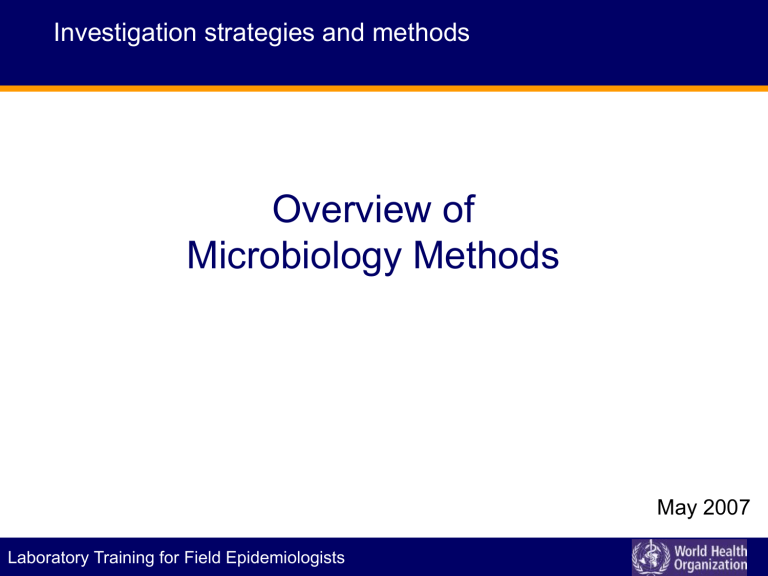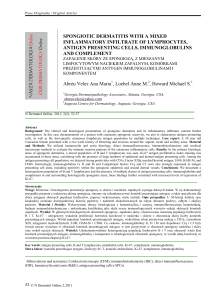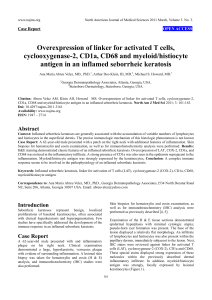Overview of Microbiology Methods Investigation strategies and methods May 2007
advertisement

Investigation strategies and methods Overview of Microbiology Methods May 2007 P I D E M I C A L E R T Laboratory Training for FieldEEpidemiologists A N D R E S P O N S E Learning objectives At the end of the presentation, participants should: • Understand what the laboratory does with samples that arrive • Have an understanding of the range of test methods used to analyse samples P I D E M I C A L E R T Laboratory Training for FieldEEpidemiologists A N D R E S P O N S E Managing the sample: administrative • When an outbreak sample is received it is assigned: • laboratory identification number • an outbreak identification label P I D E M I C A L E R T Laboratory Training for FieldEEpidemiologists A N D R E S P O N S E Managing the sample: technical • Macroscopic evaluation • Split sample for different laboratory disciplines • Two possible approaches: • perform only those tests requested by sender • perform diagnostics for syndromes/clinical description (laboratory initiative) • Storage of samples • refrigerator or freezer P I D E M I C A L E R T Laboratory Training for FieldEEpidemiologists A N D R E S P O N S E Types of laboratory methods • Direct methods • look for/detect the agent • Indirect methods • detect host response to the agent P I D E M I C A L E R T Laboratory Training for FieldEEpidemiologists A N D R E S P O N S E Direct methods 1. Macroscopic evaluation 2. Direct microscopy 3. Electron microscopy 4. Staining 5. Rapid tests 6. Molecular methods 7. Propagate the agent P I D E M I C A L E R T Laboratory Training for FieldEEpidemiologists No propagation required A N D R E S P O N S E 1. Macroscopic evaluation • Consistency • rice water stools for Cholera • Blood • Visible parasites • helminths • segments P I D E M I C A L E R T Laboratory Training for FieldEEpidemiologists A N D R E S P O N S E 2. Direct microscopy Wet mount technique Observations • white blood cells (denotes invasion) • hanging drop Dark background microscope • red blood cells • fragile organisms (e.g. spirochetes) • parasites • protozoa Viability maintained • helminths • mobility may be observed • eggs • moving bacteria P I D E M I C A L E R T Laboratory Training for FieldEEpidemiologists A N D R E S P O N S E 3. Electron microscopy Referral laboratories Examination of viruses e.g. Rotavirus in stool sample Being replaced by antigen detection Ebola virus Photo: WHO P I D E M I C A L E R T Laboratory Training for FieldEEpidemiologists A N D R E S P O N S E 4. Staining • Aspecific staining • Gram staining • Specific staining with chemicals • Ziehl Neelsen staining (Mycobacteria) • Modified Ziehl Neelsen staining (Cryptosporidium) • Specific staining with labelled antibodies • Immunofluorescence - used when gram stain cannot help in diagnosis (e.g. Legionella too small to be visible in a Gram stain) P I D E M I C A L E R T Laboratory Training for FieldEEpidemiologists A N D R E S P O N S E 5. Rapid tests • Goals • bacterial, viral or parasite antigen (surface antigen, soluble antigen) • toxin in biological fluids (e.g. cerebrospinal fluid, blood, urine) • Main techniques • direct agglutination: slides, cards • latex agglutination: slides, cards • immuno-chromatography: dipsticks P I D E M I C A L E R T Laboratory Training for FieldEEpidemiologists A N D R E S P O N S E 6. Molecular methods • Direct blotting • no amplification (enough DNA) • DNA of the agent is released – gets spotted onto a membrane and fixed – is recognized by labelled probes (hybridization) » radio-labelling » electro-luminescent labelling • Polymerase chain reaction (PCR) • amplification (not enough DNA) P I D E M I C A L E R T Laboratory Training for FieldEEpidemiologists A N D R E S P O N S E No Propagation: advantages/disadvantages • Advantages • fast (<1 hour) • inexpensive • no major laboratory infrastructure needed • Disadvantages • limited sensitivity • high concentrations needed • limited specificity P I D E M I C A L E R T Laboratory Training for FieldEEpidemiologists A N D R E S P O N S E 7. Direct Methods - propagation required • Bacteriology and mycology • most agents can be propagated on culture media • Virology • most agents can be propagated on cells • Parasitology • monocellular organisms can be propagated in culture media P I D E M I C A L E R T Laboratory Training for FieldEEpidemiologists A N D R E S P O N S E Propagation: advantages/disadvantages • Advantages • allows anti-microbial susceptibility testing • allows typing of the micro-organism • allows storage of the strain • Disadvantages • depends upon the viability/condition of the agent • takes time P I D E M I C A L E R T Laboratory Training for FieldEEpidemiologists A N D R E S P O N S E Types of laboratory methods • Direct methods • look for/detect the agent • Indirect methods • detect host response to the agent P I D E M I C A L E R T Laboratory Training for FieldEEpidemiologists A N D R E S P O N S E Indirect methods Detect 1. antibodies against the agent 2. T-cell response against the agent 3. interferon P I D E M I C A L E R T Laboratory Training for FieldEEpidemiologists A N D R E S P O N S E 1. Detecting antibodies • Precipitation • Agglutination • Haemagglutination and haemagglutination inhibition • Viral neutralization test • Radio-immunoassays • ELISA • Immunoflourescence • Immunoblotting • Immunochromatography P I D E M I C A L E R T Laboratory Training for FieldEEpidemiologists A N D R E S P O N S E Antibody detection: advantages/disadvantages • Advantages • inexpensive • easy to perform • allows identification of • IgM (acute infection) • IgG (past infection) • Disadvantages • delayed response (false negative results during sero-conversion window) • time of infection not always clear P I D E M I C A L E R T Laboratory Training for FieldEEpidemiologists A N D R E S P O N S E 2. Detection of T-cell response • Intra-dermal injection of antigen (e.g. Tuberculin skin test) • some don’t consider this a laboratory test P I D E M I C A L E R T Laboratory Training for FieldEEpidemiologists A N D R E S P O N S E T-cell response: advantages/disadvantages Advantages • • very specific and sensitive assay for tuberculosis • easy to perform Disadvantages • • delayed response (few days) • patient has to be seen twice P I D E M I C A L E R T Laboratory Training for FieldEEpidemiologists A N D R E S P O N S E Sequencing • Sequence analysis of nucleic acid fragment after PCR amplification • Compares alignment of nucleotides with other sequences present in different data bases for the identification of an agent • Confirmatory analysis • the final DNA fingerprint is molecular signature of the micro-organism P I D E M I C A L E R T Laboratory Training for FieldEEpidemiologists A N D R E S P O N S E Investigation strategies and methods Developed by the Department of Epidemic and Pandemic Alert and Response of the World Health Organization with assistance from: European Program for Intervention Epidemiology Training Canadian Field Epidemiology Program Thailand Ministry of Health Institut Pasteur P I D E M I C A L E R T Laboratory Training for FieldEEpidemiologists A N D R E S P O N S E




